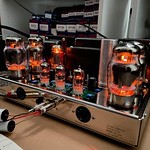 by Jim McShane Fri Aug 11, 2017 2:11 pm
by Jim McShane Fri Aug 11, 2017 2:11 pm
arledgsc wrote:When the amp is operating in Class AB you will sometimes notice non-linear performance near the zero crossing point as one tube cuts off and the other carries the peak of the waveform. This is particularly true in SS amps. A distortion analyzer would be best and and display distortion as power is increased. If the amp had low distortion until higher power output (but below rated power rating) could be a sign that operation is not linear and perhaps a mismatch of tube characteristics. Also as tubes age tube matching may not be the same as when new.
http://www.aikenamps.com/index.php/what-is-crossover-distortion
Just a couple of comments I'd like to make...
I'm not aware of any reason that a SS amp would have more tendency to have xover distortion that a tube amp. It all depends on where the tubes or SS devices are biased. There is nothing inherent in SS circuits that would be the cause.
Also the crossover distortion explanation Randall describes is theoretically spot on - he's a SHARP guy! But in the world of audio amps (and not so much musical instrument amps) I would say an amp with audible or "scopeable" crossover distortion is either in need of service or is a poor design. Simply biasing the tubes a bit deeper into class A (class A means both tubes in a push-pull amp conduct on 100% of the waveform) will minimize or eliminate the problem. Yes, the designer does have to be sure he isn't overstressing the tube by exceeding the tube dissipation ratings. and there are some other design issues involved.
Keep in mind that class AB operation can encompass a wide range of bias points since class A means both tubes conduct all the time and class B means the tubes conduct exactly 50% of the time. So class AB means the tubes conduct more than 50% but less than 100% of the time. And as you can imagine the difference between an amp operating at 50.01% and 99.9% is significant! At 50.01% even a small audio signal applied to the tube grid can drive the output tubes into cutoff; whereas at 99.9% it takes a very large signal to drive the stage into cutoff.
So the odds of experiencing crossover distortion vary depending on how deeply into class A the amp is biased! Remember deeper into class A means FARTHER from class B and the distortion that results.
Last edited by Jim McShane on Fri Aug 11, 2017 2:14 pm; edited 1 time in total (Reason for editing : Correct typo)



